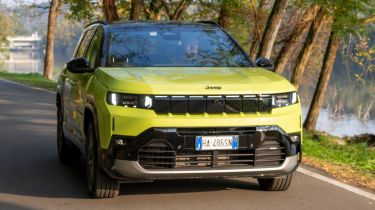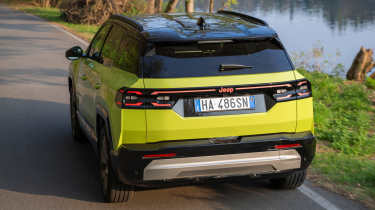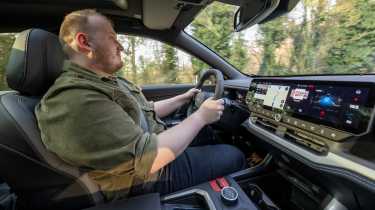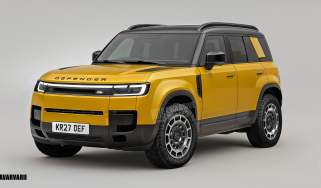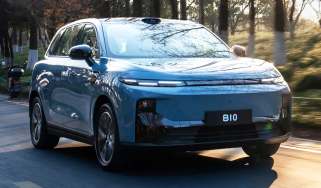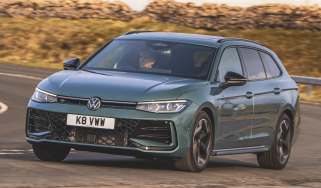New Jeep Compass e-Hybrid 2025 review: revamped SUV ticks all the right boxes
The latest Jeep Compass gets a new look inspired by the Avenger, but it's far more than just a pretty face

Verdict
The new Jeep Compass capitalises on the enormous success of the smaller Avenger, by offering a similar combination of ruggedly handsome looks, an interior built to last, good on-board tech and a selection of powertrains that should suit every customer in its segment. Sure, this is not as fun to chuck around as its baby brother, or the plushest mid-size SUV around, but it’s perfectly practical and plays off Jeep’s off-road heritage, even if the most treacherous conditions it’s likely to ever see is a gravel school car park.
Three years ago, the Jeep Avenger burst on to the scene like Kevin Hart – small, fun, energetic and versatile. The baby SUV may be the antithesis of the unstoppable four-wheel-drive Wrangler that the brand is famous for, but clearly that's what people wanted. More than 200,000 have been sold so far, mostly in Europe.
With Jeep’s UK sales now triple what they were before the arrival of the Avenger, the decision to take the best-seller’s winning formula and super-size it to create the new third-generation Jeep Compass is the definition of a no-brainer.
Underneath, the new Compass uses the same STLA Medium platform as the latest Citroen C5 Aircross, Peugeot 3008 and Vauxhall Grandland, and eventually it’ll be available with the same selection of hybrid, plug-in hybrid and pure-electric powertrains.
Used - available now

2023 Jeep
Compass
46,086 milesAutomaticPetrol1.3L
Cash £15,800
2020 Jeep
Compass
38,000 milesManualPetrol1.4L
Cash £12,994
2020 Jeep
Compass
46,586 milesManualPetrol1.4L
Cash £12,649
2020 Jeep
Compass
43,900 milesManualPetrol1.4L
Cash £12,990This being a Jeep, a lot of time and effort has gone into ensuring the new Compass is capable of getting down and dirty. Extremely short overhangs at the front and rear create the best approach, departure and break-over angles of any SUV on this platform. It also has more than 200mm of ground clearance and a maximum wading depth of 470mm.
Not exactly key criteria for family SUV buyers, but it’s what people expect from a Jeep and will give them confidence when a festival car park turns into a total quagmire. As do the dedicated ‘Selec-Terrain’ modes for Snow and Sand/Mud, which alter the power delivery and traction control.
As you can see, all the key Jeep styling traits are present and correct, including the squared-off wheelarches and the brand’s iconic seven-slot grille design. It’s blanked-off, like the Avenger’s, but on certain models each segment is illuminated. The front camera is located on the grille too, to hopefully prevent it being damaged by debris.
The new Compass is a huge step forward in interior design, quality and technology over the previous generation. Every model features a 10-inch instrument panel with clear, simple graphics, and a whopping 16-inch touchscreen. Jeep’s latest infotainment system offers lots of functionality with three customisable widgets on the homepage, plus climate controls permanently displayed on either side. Including if you connect to Apple CarPlay or Android Auto (both wireless).
We found menus don’t always load instantly, and you do have to have to be quite precise about how you press or swipe on the homescreen to ensure you interact with the right widget block. Luckily there is a row of shortcut buttons below the display, including one for the ADAS menu that will switch off selected safety systems if you press for long enough.
We like that the squared-off steering wheel has chunky buttons as well, while the tall centre console gets a big red toggle switch for the drive modes and a rotary gear selector that’s well damped, and surprisingly satisfying to use. The leather on the dashboard is a nice touch, and everything feels sturdy, but there is still a lot of plastic in here.
On one hand, the plastics, thick rubber floor mats and fabric seat upholstery suits this car’s persona, and there are some Jeep ‘easter eggs’ dotted around. However we understand buyers may want a mid-size SUV that looks and feels more high-quality. If that’s you, the Hyundai Tucson, Nissan Qashqai and Volkswagen Tiguan spring immediately to mind.
There were also a few electrical gremlins in the two models we tested. It took several minutes for the head-up display in the first to wake up, and the sunroof in the second refused to do anything. Luckily it was closed.
In terms of space, the Compass offers plenty of storage for the detritus that family life generates, with 34 litres worth offered by various trays and cubbies. The back seats offer more than enough legroom for six-feet-tall adults, as well as adequate headroom – a benefit of the car’s boxy shape. We think you could just about squeeze three people onto the rear seats, or if you have small children there are two sets of Isofix mounting points on the outer seats covered by zips.
The Compass offers 550 litres of boot space, which puts it in the middle of the mid-size SUV pack. The Qashqai offers up to 504 litres, for instance, while the Kia Sportage has a 591-litre load area. At least there’s space under the boot floor in the EV for the charging cables.
There will only be one all-wheel-drive version of the new Compass, which isn’t arriving until next year and will be a dual-motor EV. The Vauxhall Grandland is now available with a similar set-up, but the Jeep gets a unique e-motor for the rear axle that supposedly can deliver up to 3100Nm of torque at the wheels – the perfect amount, we’ve been told, for the car to conquer a 20 degree slope with absolutely no traction on the front wheels.
As well as extra traction, the all-wheel-drive Compass 4xe will deliver a combined 370bhp and even greater off-road ability, thanks to an extra 10mm of ground clearance.
That’s still to come, as is the e-Hybrid Plug-In version that will pair a 1.6-litre four-cylinder petrol engine with a single e-motor and 17.9kWh battery pack for more than 50 miles of pure-electric driving range. There’s also going to be a long-range version of the Compass Electric with a substantial 97kWh battery and up to 403 miles of range.
For now, the Jeep Compass is available with a turbocharged 1.2-litre three-cylinder petrol engine and a six-speed dual-clutch automatic transmission that has a 21bhp electric motor built-in. Or as an EV with a single 210bhp e-motor and 73kWh battery providing up to 310 miles of range. We were fortunate to try both on the outskirts of Milan.
In the hybrid, when you’re not driving on the e-motor (you can tell because the speedo turns blue) the three-pot engine hums away in the background. Put your foot down, and there’s a slight delay until the gearbox finally decides to kick down, then the engine emits a rather gruff drone as you very steadily gain speed. If you need to accelerate hard, such as when joining the motorway, we suggest using the paddles behind the steering wheel to force the gearbox into action.
The Compass Electric provides smoother acceleration and a generally more refined driving experience, helped by its one-pedal driving capability. We did notice some whine from the EV’s motor though, and a fair amount of road noise coming into the cabin in both versions.
Visibility is decent and the driving position is suitably tall. The big, heavily sculpted bonnet not only makes you feel like you’re driving a much larger 4x4, the squared edges actually help with placing the car on the road, particularly in town.
While the suspension does a decent job of absorbing the impacts from imperfections in the road, the ride feels slightly lumpy, and the car thumbs when you drive over potholes and the like. It rolls through corners too, but that’s hardly surprising.
From November, Jeep will offer the Compass in entry-level Altitude trim, with prices starting from £34,520 for the hybrid version and £38,200 for the EV. Standard equipment will include the two big displays, wireless smartphone connectivity, LED headlights, cloth seats, keyless entry, adaptive cruise control and various safety systems.
For context, the Peugeot 3008 starts from nearly £38k, while the E-3008 starts from more than £46k. Whereas the Citroen C5 Aircross is available from £30k and the base E-C5 Aircross costs about £32k – thanks in part to the Government’s Electric Car Grant, which the Jeep isn’t eligible for.
However at the time of writing, only First Edition specification is available, and costs about £1,000 more than Altitude models will. For that though, you get an illuminated grille, matrix LED headlights, heated seats and heated steering wheel, handsfree tailgate, wireless charging pad and 20-inch rims.
Did you know you can sell your car through Auto Express? We’ll help you get a great price and find a great deal on a new car, too.
| Model: | Jeep Compass e-Hybrid First Edition |
| Price: | £35,700 |
| Powertrain: | 1.2-litre 3cyl petrol hybrid |
| Power/torque: | 142bhp/230Nm |
| Transmission: | Six-speed dual-clutch automatic, front-wheel drive |
| 0-62mph: | 10.3 seconds |
| Top speed: | 117mph |
| Economy/CO2: | 47.9mpg/133g/km |
| Size (L/W/H): | 4,552/1,928/1,675mm |
| On sale: | Now |

